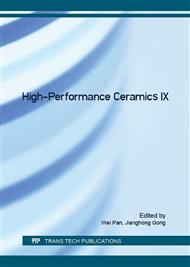p.193
p.198
p.203
p.207
p.211
p.219
p.223
p.227
p.231
Effect of Buried Powder Sintering on the Electrical and Piezoelectric Properties of CuO-Modified (Li,K,Na)(Nb,Sb)O3 Lead-Free Piezoceramics
Abstract:
A strong desire for environmental protection and human health care urgently requires us to find an environmental friendly type of piezoelectric material to replace the lead ones. In this study, (LixK0.5-xNa0.5)(Nb0.97Sb0.03)O3-1mol%CuO (x = 0, 0.05, 0.1 ,0.2 ,0.5, abbreviated as CuO-LxKNNS) lead-free piezoelectric ceramics have been fabricated by a conventional solid-state reaction route. We focused on the comparison of buried powder sintering with exposed sintering. The effect of buried powder sintering method on density, structure and dielectric, piezoelectric properties of CuO-LxKNNS ceramics has been investigated. It was found that the density increased greatly when the buried powder sintering method was used, which was effective in inhibiting the volatilization of alkali metal oxides compared with exposed sintering method. Piezoelectric and dielectric properties showed a similar tendency with the density. These ceramics showed an obvious phase transition with increasing the Li content. CuO-LxKNNS ceramics showed orthorhombic symmetry when x= 0, but turned to be tetragonal symmetry when x ≥ 0.05. The optimal composition of CuO-LxKNNS with buried powder sintering method was x = 0.05 sintered at 1020 °C, for which the maximum value of the piezoelectric constant (d33) was 180pC/N, the density (ρ) was 4.40g/cm3, the room temperature relative dielectric constant (εr) was 270 and the dielectric loss (tanδ) was 0.07.
Info:
Periodical:
Pages:
211-215
Citation:
Online since:
July 2016
Authors:
Price:
Сopyright:
© 2016 Trans Tech Publications Ltd. All Rights Reserved
Share:
Citation:


